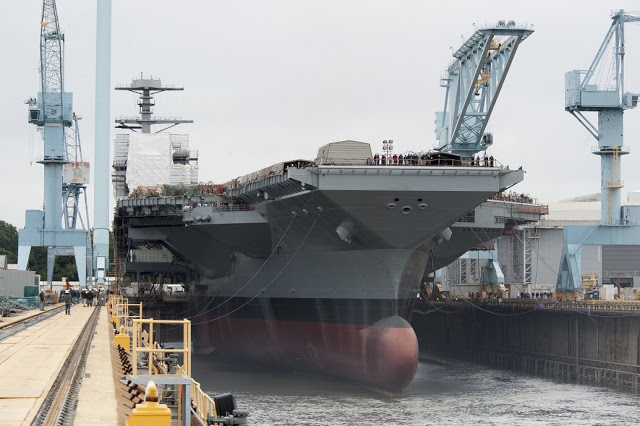The program is now $6 billion over budget, according to a review by McCain’s staff. And while the lead ship is expected to be delivered next year, the second ship in the fleet is five years behind schedule and won’t be ready until 2024. The first ship will also be incomplete when delivered.
In an attempt to contain the cost of the ships, built by Newport News-based Huntington Ingalls Industries, Congress imposed caps. But those were blown, and now the cost of the first ship is estimated to be nearly $13 billion.
The Ford-class carriers suffered from unrealistic cost estimates and overly optimistic timelines. And key Pentagon officials pushed the program forward even though key technologies hadn’t been fully tested, developed or designed, officials testified.
As early as 2007, before the Navy awarded the contract to build the ship, the GAO said that there “were key risks in the program that would impair the Navy’s ability to deliver [the first ship] at cost, on time and with its planned capabilities.” The program consists of three nuclear-powered ships designed to serve as successors to the Nimitz-class carriers.
The GAO even predicted in 2007 that the cost of the first ship was in danger of going 22 percent over budget. “Fast forward to today, 2015, cost increases are 22 percent,” said Paul Francis, the GAO’s managing director of Acquisition and Sourcing Management.
The undersecretary’s office authorized the Navy to begin construction “when only 27 percent of the ship was designed and just five of its 13 new systems were mature,” McCain said. And it failed to heed the warnings from watchdogs and weapons testers.
Doomed on Arrival
Henry J. Hendrix of the Center for a New American Security argues that, like the battleships which carriers were originally designed to support, carriers may now be too expensive and vulnerable. US aircraft carriers are doomed and so are the Chinese aircraft carriers in terms of an actual war with a relatively equal opponent. They are useful for projecting power and bullying vastly weaker opponents.
China has developed land-based anti-ship missiles to force carriers to operate so far from targets that manned aircraft might become less useful than unmanned combat aerial vehicles (UCAVs) operating from smaller, less expensive carriers.
The newest carrier, the USS Gerald R. Ford, to be commissioned next year, costs $12.8 billion. Add the costs of the air wing, the support of five surface combat ships and one attack submarine, and 6,700 sailors. The bill for operating a carrier group: $2.5 million a day.
China, says Hendrix, could build more than 1,200 of its premier anti-ship missiles for the cost of one Ford carrier, and one of the 1,200 could achieve “mission-kill,” removing the carrier from the fight for months.
It might be smart to reduce spending on the astonishingly expensive and operationally dubious F-35 Joint Strike Fighter, and redirect the money to unmanned combat aircraft that could extend, for a while, the carriers’ viability. For $3 billion the Navy could have 10 more nimble littoral combat ships providing increased day-to-day presence.
Furthermore, of the 14 Ohio-class ballistic missile submarines that were built for 30-year lives, the youngest is 17 and all might be kept in service until they are 40. Buying conventional guided-missile variants of these stealthy arsenals would bring many precision-strike missiles close to land targets, obviating anti-surface-ship missiles.

Brian Wang is a Futurist Thought Leader and a popular Science blogger with 1 million readers per month. His blog Nextbigfuture.com is ranked #1 Science News Blog. It covers many disruptive technology and trends including Space, Robotics, Artificial Intelligence, Medicine, Anti-aging Biotechnology, and Nanotechnology.
Known for identifying cutting edge technologies, he is currently a Co-Founder of a startup and fundraiser for high potential early-stage companies. He is the Head of Research for Allocations for deep technology investments and an Angel Investor at Space Angels.
A frequent speaker at corporations, he has been a TEDx speaker, a Singularity University speaker and guest at numerous interviews for radio and podcasts. He is open to public speaking and advising engagements.








